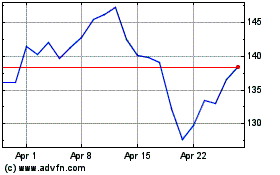U.S. Moving Forward With Rule to Limit Chips to Huawei -- Update
March 26 2020 - 11:23PM
Dow Jones News
By Bob Davis and Katy Stech Ferek
WASHINGTON -- The Trump administration is moving ahead with new
restrictions aimed at cutting off Chinese telecom-equipment maker
Huawei Technologies Co. from one of its main suppliers of advanced
semiconductors, according to people familiar with the
situation.
At a meeting on Wednesday, top cabinet officials agreed to
advance a proposal to hobble Huawei, according to these people. The
U.S. alleges Huawei gear could be used by Beijing to spy globally,
which Huawei has repeatedly denied.
Specifically, the rule would require an export license for many
chips shipped to Huawei that are produced by U.S.-designed
chip-making tools. That would give the Commerce Department the
ability to block the sale of semiconductors manufactured by Taiwan
Semiconductor Manufacturing Co., for Huawei's HiSilicon unit, which
designs chips for the company.
The restrictions would also disadvantage U.S. companies that
produce the semiconductor manufacturing equipment used by TSMC, the
world's largest contract-chip maker. The semiconductor industry has
waged a monthslong campaign against the anti-Huawei rules, arguing
that the chips being sold don't pose national-security concerns and
would undermine U.S. companies' ability to compete with foreign
firms.
A TSMC spokeswoman said the company wouldn't answer hypothetical
questions about the restrictions and doesn't comment on any
individual customer. Huawei didn't immediately respond to a request
for comment.
The rule now has to be written, a process that could take weeks,
if not longer, giving the semiconductor industry time to try to get
it revised or watered down. The plan currently is to have the
proposed restrictions go into effect before the industry has a
chance to comment, said the people familiar with the situation.
The potential curbs could still hit barriers within the
administration or with President Trump. Last month, Mr. Trump
denounced efforts to halt the export of restricted technologies --
including jet engines and semiconductors -- to China.
"We don't want to make it impossible to do business with us,"
Mr. Trump tweeted.
The Wednesday meeting was largely called to figure out a way to
write regulations to carry out Mr. Trump's orders to scrap an
earlier plan to limit engine sales. The chip-tool proposal is a
small part of restrictions initially planned for Huawei, but which
were abandoned after Mr. Trump made his preferences clear.
An outline of the chip-tool plan was earlier reported by
Reuters.
The new rule is aimed at a crucial slice of the global
semiconductor-manufacturing industry.
The U.S.'s top three semiconductor equipment makers -- Applied
Materials Inc., Lam Research Corp. and KLA Corp. -- control roughly
40% of the global market by revenue. Much of the equipment used in
chip assembly lines world-wide incorporate American-made
technology. In addition, the most widely used software to design
chips is American-made.
The rules would tighten the country's U.S. export-control system
that has already placed some restrictions on Huawei.
In May, Commerce Department officials put Huawei on an export
blacklist that they keep of companies considered to be
national-security threats.
The move was designed to cut Huawei off from some U.S.
semiconductor makers -- Micron Technology Inc., Qualcomm Inc. and
Intel Corp. -- and other companies that have sent billions of
dollars' worth of components to Huawei.
But some Trump administration officials have been frustrated
that this step doesn't appear to have hurt Huawei financially.
Shortly after the ban, some semiconductor makers found exceptions
in the blacklist's rules that enabled them to resume shipments in
cases where chips were produced mainly overseas.
The Commerce Department had come up with ways to limit those
sales too, but has given up on that attempt because Mr. Trump said
he didn't want to halt chip sales, said people familiar with the
situation.
Huawei leaders, meanwhile, have boasted about finding ways to
make its equipment without U.S.-made semiconductors.
Asa Fitch and Alex Leary contributed to this article.
Write to Bob Davis at bob.davis@wsj.com and Katy Stech Ferek at
katherine.stech@wsj.com
(END) Dow Jones Newswires
March 26, 2020 23:08 ET (03:08 GMT)
Copyright (c) 2020 Dow Jones & Company, Inc.
Taiwan Semiconductor Man... (NYSE:TSM)
Historical Stock Chart
From Mar 2024 to Apr 2024

Taiwan Semiconductor Man... (NYSE:TSM)
Historical Stock Chart
From Apr 2023 to Apr 2024
